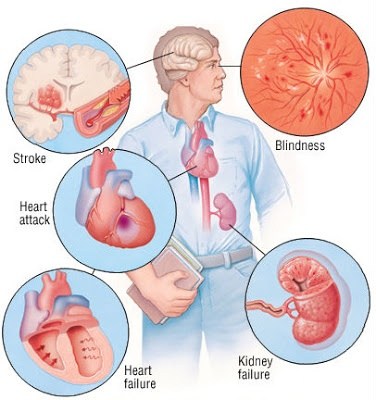
The determinants of arterial blood pressure are the cardiac out put and the peripheral resistance. These two can be considered as the physiological factors, while the blood volume and the compliance of the arteries are taken as the physical factors determining the arterial blood pressure.
The systolic pressure is maintained by the cardiac output. This in turn depends upon the product of stroke volume and heart rate. The diastolic pressure is due to peripheral resistance present in the arterioles. The mean pressure of 100 mmHg in adult depends on the balance between the amount of blood pumped into the aorta and the amount of blood leaving the arterioles (peripheral run off. Normally the amount of blood pumped into the aorta in each beat is 70 ml. If there is a rise in stroke output, as in exercise, the amount of blood entering the arterial system increases, while the amount of blood leaving the arterioles remains the same. This will lead to stretching of arteries, which increases the systolic pressure. The rise in systolic pressure will give a greater pressure head for the extra volume of blood to leave the arterioles.
If the amount of blood pumped into the arterial system falls, as in heart failure or in hemorrhagic shock, the mean pressure in the arterial system will decrease.Decrease in arterial compliance (increased stiffness of arteries) will lead to rise in systolic pressure, which is much greater than the rise in diastolic pressure. is the resistance present in the arterioles due to the presence of thick smooth muscle in the wall.
The resistance also causes sharp decline in the mean blood pressure in the arterioles. This peripheral vessel offers resistance to the flow of blood leaving the arterial system. It indicates the resistance against which the left ventricle has to contract. This resistance will also give afterload to the heart.
Total peripheral resistance (R) is also expressed in units. Its normal value is 1 unit. The value increases in arterial hypertension.
Rise in peripheral resistance reduces the peripheral run off and this increases the arterial blood volume. The balance between the blood pumped into the aorta and the amount leaving the arterioles cannot be maintained. To maintain the balance, the mean pressure in the arterial system should be increased. There is rise in systolic and diastolic pressures and the rise in the latter, increases the workload on the heart, making it prone for infarction.
Peripheral resistance is also influenced by the elasticity of arteries, viscosity and velocity of blood. As described above, the loss of elasticity will increase the resistance and raises the mean pressure. Rise in viscosity of blood, as in increased hematocrit, will increase the peripheral resistance and hence the rise in diastolic pressure. Similar effect can be seen when the velocity of blood flow is decreased.
Source: Textbook of Physiology, 3E (Chandramouli) (2010)